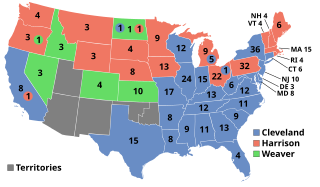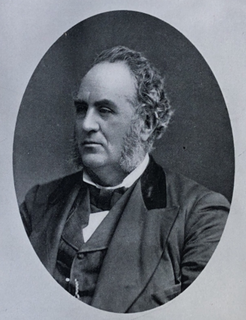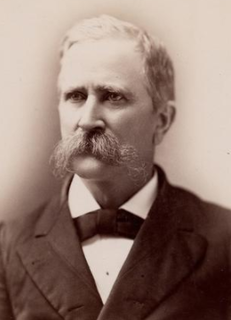
The Constitution Party, formerly the U.S. Taxpayers' Party until 1999, is a political party in the United States that promotes a religious conservative view of the principles and intents of the United States Constitution. The party platform is based on originalist interpretations of the Constitution and shaped by principles which it believes were set forth in the Declaration of Independence, the Bill of Rights, the Constitution and the Bible.

The 1876 United States presidential election was the 23rd quadrennial presidential election, held on Tuesday, November 7, 1876 in which Republican nominee Rutherford B. Hayes faced Democrat Samuel J. Tilden. It was one of the most contentious presidential elections in American history. Its resolution involved negotiations between the Republicans and Democrats, resulting in the Compromise of 1877, and on March 2, 1877 the counting of electoral votes by the House and Senate occurred, confirming Hayes as President. It was the second of five U.S. presidential elections in which the winner did not win a plurality of the national popular vote.

The 1852 United States presidential election was the 17th quadrennial presidential election, held on Tuesday, November 2, 1852. Democrat Franklin Pierce defeated Whig nominee General Winfield Scott.

The 1884 United States presidential election was the 25th quadrennial presidential election, held on Tuesday, November 4, 1884. It saw the first Democrat elected President of the United States since James Buchanan in 1856, and the first Democratic president to hold office since Andrew Johnson, who assumed the presidency after the assassination of Abraham Lincoln. Governor Grover Cleveland of New York defeated Republican James G. Blaine of Maine. The election was set apart by unpleasant mudslinging and shameful personal allegations that eclipsed substantive issues, for example, civil administration change. It was a historically significant election, as Cleveland was the only Democratic president between Andrew Johnson, who left office in 1869, and Woodrow Wilson, who began his first term in 1913, representing a disruption of the period of Republican domination of the presidency between Reconstruction and the Great Depression.

The 1888 United States presidential election was the 26th quadrennial presidential election, held on Tuesday, November 6, 1888. Republican nominee Benjamin Harrison, a former Senator from Indiana, defeated incumbent Democratic President Grover Cleveland of New York. It was the third of five U.S. presidential elections in which the winner did not win a plurality of the national popular vote, which would not occur again until the 2000 US presidential election.

The 1892 United States presidential election was the 27th quadrennial presidential election, held on Tuesday, November 8, 1892. In a rematch of the closely contested 1888 presidential election, former Democratic President Grover Cleveland defeated incumbent Republican President Benjamin Harrison. Cleveland's victory made him the first and, to date, the only person in American history to be elected to a non-consecutive second presidential term. It was also the first time incumbents were defeated in consecutive elections—the second being Jimmy Carter's defeat of Gerald Ford in 1976, followed by Carter's subsequent loss to Ronald Reagan in 1980. Additionally, Harrison's loss marked the second time an elected president lost the popular vote twice, the first being John Quincy Adams in the 1820s. This feat was not repeated until Donald Trump lost the popular vote in 2016 and 2020. The election also marks the only time other than Trump's loss in 2020 in which the Republican party was voted out of the White House after a single term.

The 1908 United States presidential election was the 31st quadrennial presidential election, held on Tuesday, November 3, 1908. Secretary of War and Republican Party nominee William Howard Taft defeated three-time Democratic nominee William Jennings Bryan.

The 1932 United States presidential election was the 37th quadrennial presidential election, held on Tuesday, November 8, 1932. The election took place against the backdrop of the Great Depression. Incumbent Republican President Herbert Hoover was defeated in a landslide by Democrat Franklin D. Roosevelt, the Governor of New York and the vice presidential nominee of the 1920 presidential election. Roosevelt was the first Democrat in 80 years to win an outright majority in the popular and electoral votes, the last one being Franklin Pierce in 1852. Hoover was the last incumbent president to lose reelection until Gerald Ford lost 44 years later. The election marked the effective end of the Fourth Party System, which had been dominated by Republicans.

The Prohibition Party (PRO) is a political party in the United States known for its historic opposition to the sale or consumption of alcoholic beverages and as an integral part of the temperance movement. It is the oldest existing third party in the United States and the third-longest active party.
Earl Farwell Dodge Jr. was an American politician who served as the Prohibition Party's chairman and presidential candidate from the 1984 to 2000 presidential elections and later ran with the nomination of his own faction during the 2004 presidential election.

Eugene Wilder Chafin was an American politician and writer who served as the Prohibition Party's presidential candidate during the 1908 and 1912 presidential elections. He was active in local politics in Wisconsin, statewide elections in Wisconsin, Illinois, and Arizona, and campaigned throughout the United States and the world in favor of the prohibition of alcohol.

James Black was an American temperance movement activist and a founder of the Prohibition Party. Black served as the first presidential nominee of the Prohibition Party during the 1872 presidential election.

Gideon Tabor Stewart was an American lawyer and politician who served as the Prohibition Party's vice presidential nominee in 1876. He was elected three times as grand worthy chief templar of the Good Templars of Ohio.
The 1928 Democratic National Convention was held at Sam Houston Hall in Houston, Texas, June 26–28, 1928. Keynote speaker was Claude G. Bowers. The convention resulted in the nomination of Governor Alfred E. Smith of New York for president and Senator Joseph T. Robinson of Arkansas for vice president.
The 1876 Democratic National Convention assembled in St. Louis just nine days after the conclusion of the Republican National Convention in Cincinnati.
The 1848 Democratic National Convention was a presidential nominating convention that met from monday May 22 to thursday May 25 in Baltimore, Maryland. It was held to nominate the Democratic Party's candidates for president and vice president in the 1848 election. The convention selected Senator Lewis Cass of Michigan for president and former Representative William O. Butler of Kentucky for vice president.
The 1884 Democratic National Convention was held July 8–11, 1884 and chose Governor Grover Cleveland of New York their presidential nominee with the former Governor Thomas A. Hendricks of Indiana as the vice presidential nominee.

The 1872 Prohibition National Convention was a presidential nominating convention held at Comstock's Opera House, in Columbus, Ohio on February 22, 1872, to select the presidential ticket for the 1872 presidential election. It was the first presidential nominating convention of the newly organized Prohibition Party and would continue nominating presidential candidates in every presidential election leading it to become the longest continuous third party in the United States.

The 1880 Prohibition National Convention was a presidential nominating convention held at Halle's Hall, in Cleveland, Ohio on June 17, 1880, to select the Prohibition Party's presidential ticket for the 1880 presidential election.

The 1884 Prohibition National Convention was a presidential nominating convention held at Lafayette Hall, in Pittsburgh, Pennsylvania from July 23–24, 1884, to select the Prohibition Party's presidential ticket for the 1884 presidential election.
















